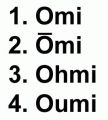
Spelling Long Vowels
Spelling long vowels has been and will always be a permanent problem for all of us. There is no perfect way to spell long vowels in Japanese words. So people spell long vowels in different ways, which makes it confusing for everyone.
For example, 近江(おうみ).
See the image for the sample spellings.
I always spell it as “Omi,” which is the most common and practical way to spell it. The best way is actually #2 which has a macron to indicate a long vowel sound. A macron is a small horizontal bar above the vowel.
The problem with #2 is that it is troublesome to type a macron. I was unable to type it here in mixi, so I use this image to show you. Most English newspapers, magazines, and books also do not type a macron. It is too much trouble.
Using a macron for long vowels is actually the Hepburn system. JR train stations and subway stations follow the Hepburn system so they all use macrons too.
A macron helps us to pronounce the name more accurately. Those of us familiar with Japanese will very much appreciate macrons. So in J-E romanized dictionaries and Japanese textbooks, you may find it.
However, to people who don’t know Japanese, a macron makes no difference. They will pronounce the word in the same way, with or without the macron.
Since it is too troublesome (or impossible) to type a macron, some people insert an “h” to indicate long vowels like #3. For example, 近江鉄道 and 近江バス spell it “Ohmi.”
https://photoguide.jp/pix/displayimage.php?album=147&pos=67
The problem with “Ohmi” is that it can be confused with おおみ instead of おうみ. Many people use “h” to spell the double o (おお) such as 大津 (Ohtsu), 太田 (Ohta), and 大井 (Ohi). The “h” looks very awkward and it is completely unnecessary for normal English speaking. People who don’t know Japanese will not understand the difference between Otsu and Ohtsu anyway. The “h” has no real pronunciation value or indicator in English.
Also remember that we always spell 大阪 as “Osaka,” not “Ohsaka.” And regarding 大井, “Ohi” will make it おひ instead of おおい. This is another reason to avoid using “h.”
Of course, nobody spells 大津 as “Ootsu.” It looks too strange. So there is no reason to spell 近江 as “Oumi.” This is another spelling method you should avoid (except when you are teaching Japanese or typing kanji). “Oumi” will likely invite mispronunciation by someone who doesn’t know Japanese. And remember that 東京 is always “Tokyo,” not “Toukyou.”
Also for 町, such as Aisho-cho, best to spell it “cho” and not “choh” or “chou.”
Note also 甲賀市 (Koka), 栗東市 (Ritto), 甲良町 (Kora), 竜王町 (Ryuo), 蒲生郡 (Gamo), 余呉町 (Yogo). Be careful when you spell these place names having long vowel sounds.
最後の注意:
If the name of a person or company has a long vowel sound, you should check how they spell it and follow their preference. So please spell 近江鉄道 as “Ohmi Railway” and 近江バス as “Ohmi Bus.” It is their name and their preference, so you should respect it.
When you write someone’s name in English, also check how they spell it. Maybe you can check their English 名刺. But you should always respect how a person or company spells their corporate or personal name.
Next time you pass by 近江八幡駅 or 近江今津駅, notice the romanization of the train station name.